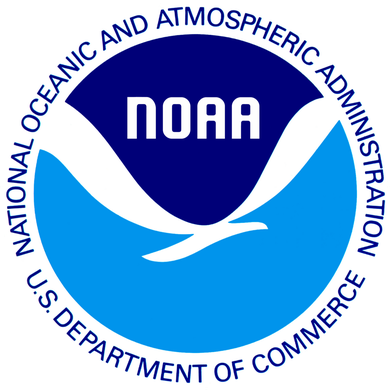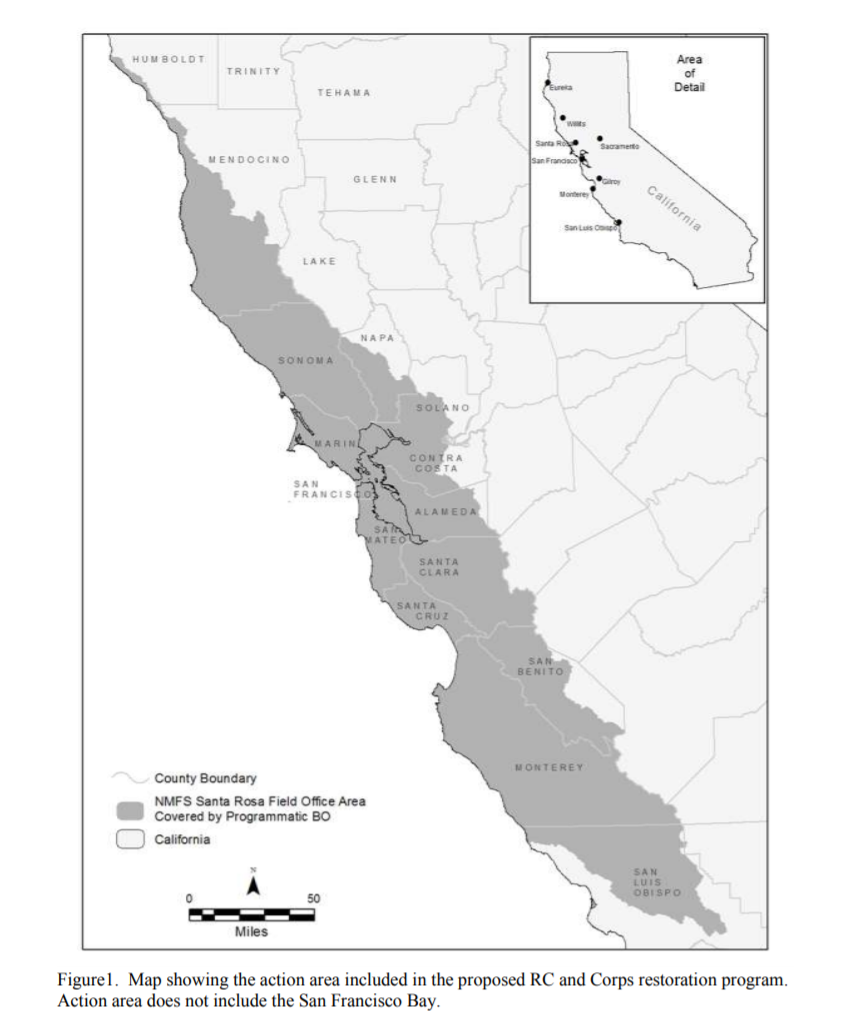Agency or authority
What this permitting pathway covers
Using this process for coverage under Section 7 of the Endangered Species Act for NMFS species is a faster and lower-cost process than writing a biological assessment and receiving a biological opinion for your individual project.
Eligibility
To be eligible for this Program a restoration project must have a federal nexus (e.g. typically federal permitting or funding from a federal agency). A permit from the Army Corps (Section 404 or Section 10) is often a federal nexus.
Protection Measures Selection Tool
Protection measures from this PBO can be filtered based on project activities using Sustainable Conservation’s Protection Measures Selection Tool.
Restoration Consistency Determination
The NOAA Restoration Center (RC) coordinated with the California Department of Fish and Wildlife (CDFW) and added language to the Incidental Take Statement so that CDFW can issue Restoration Consistency Determinations for this PBO, providing another permitting efficiency.
Applicable locations
The Program area includes Humboldt (Central California Coast coho salmon ESU only), Mendocino (excluding the Eel and Mattole River watersheds), Sonoma, Marin, Napa, Solano, Contra Costa, Alameda, Santa Clara, San Francisco, San Mateo, Santa Cruz, San Benito, Monterey, and San Luis Obispo counties (see Figure 1 below).
Permit documents
- Central Coast NMFS PBO
- Revised Incidental Take Statement - August 2022
- Central Coast NMFS BO Programmatic Approach
- Application Checklist for Inclusion in the Program
- Post-Project Construction Monitoring Form
Expires on
No expiration date
How to apply
Contact Sarah Nossaman Pierce, Marine Habitat Resource Specialist at the NOAA Restoration Center in Santa Rosa, CA at sarah.pierce@noaa.gov to discuss your project.
May be used with:
- North and Central Coast Federal Consistency Determination (CD) – Coastal Commission and NOAA Restoration Center
- USACE Nationwide Permit 27 – Aquatic Habitat Restoration
- USACE Nationwide Permit 33 – Temporary Construction, Access, and Dewatering
- CDFW Habitat Restoration and Enhancement Act (HREA)
- CDFW Restoration Consistency Determination (CD)
- CDFW Restoration Management Permit (RMP)
- CDFW Fisheries Restoration Grant Program (FRGP)
- CEQA Categorical Exemption 15333 – Small Habitat Restoration Projects
- CEQA Programmatic EIR for the State Water Resources Control Board Statewide Restoration General Order (SRGO PEIR)
- CEQA Statutory Exemption for Restoration Projects (SERP) – CDFW
- Water Board Order for Small Habitat Restoration Projects
- Water Board Statewide Restoration General Order (SRGO)
- USFWS Statewide Restoration Programmatic Biological Opinion (PBO)
- Marin Permit Coordination Program
- NOAA Restoration Center Programmatic Environmental Impact Statement (EIS)
Example projects
Species covered
- Central California Coast (CCC) coho salmon (Oncorhynchus kisutch)
- Northern California (NC) steelhead (Oncorhynchus mykiss)
- California coastal Chinook (Oncorhynchus tshawytscha)
- Central California Coast (CCC) steelhead (Oncorhynchus mykiss)
- South-Central California Coast (S-CCC) steelhead (Oncorhynchus mykiss)
- Green sturgeon (Acipenser medirostris)
- Essential Fish Habitat – Pacific Coast Salmon, Pacific Coastal Groundfish, Coastal Pelagic
Activities covered
Full details on eligible program activities start on page 4 of the Programmatic Approach document.
- Instream Habitat Improvements
- Instream Barrier Modification for Fish Passage Improvement
- Stream Bank and Riparian Habitat Restoration
- Upslope Watershed Restoration
- Removal of Small Dams (permanent, flashboard, and other seasonal-type)
- Creation of Off-channel/Side-channel Habitat Features
- Water Conservation Projects (includes developing alternative off-stream water supply, water storage tanks, and installation of water measuring devices)
Sideboards
- Any stream crossing removals in a salmonid-bearing stream must be 1500 meters apart.
- Crossings in a non-fish bearing stream must be 100 feet apart
- Maximum length of stream dewatered per project: 1,000 cumulative linear feet
- The disturbance footprint for a project’s staging areas may not exceed a total of 1 acre.
- Native trees with defects, large snags > 16 in. diameter at breast height (dbh) and 20 ft. high, cavities, leaning toward the stream channel, nests, late seral characteristics, or > 48 in. dbh will be retained. In limited cases removal will be permitted if trees/snags occur in the way of providing fish passage. No removal will occur without a site visit and written approval from the RC.
- Downed trees (logs) > 24 in. dbh and 10 ft. long will be retained on upslope sites or used for instream habitat improvement projects.
Exclusions
Projects with a stream dewatering length over 1000 linear feet at any one project site.
Application Tips and Resources
Project Review
The NOAA Restoration Center (RC) strongly recommends contacting NOAA RC staff in Santa Rosa, CA to discuss your project (see How to apply on the right) before starting to write your application, as they administer and oversee the Program. The RC leads the program and participates in the screening of individual projects under consideration for inclusion in the Program, and tracks the implementation of individual projects.
Many applications to this Program may receive technical assistance and approval from, the RC’s Community based Restoration Program. Projects funded by various other sources must receive a 404 permit from the Corps (San Francisco District) or ESA consultations from NMFS and/or USFWS and must meet all the requirements and limitations described in the Program and any other measures such as terms and conditions.
Project applicants will submit information either to the Corps (as part of their application for a Corps permit) or the RC (for RC-funded projects). RC and Corps staff use a pre-established checklist (called the “Application Checklist for Inclusion in the RC Santa Rosa Office Programmatic Approach”) to determine whether the project meets the parameters of the Program. Field visits may be necessary before projects are authorized for inclusion under the Program.
The RC may see the need to have designs reviewed by either NMFS Environmental Services Branch (ESB) or CDFW engineers on more complex project types.
The transmittal and response emails will be maintained in each project file by the RC and or the Corps.
Post-Construction Monitoring and Reporting
Qualifying applicants will be required to carry out all post-construction implementation monitoring for projects authorized under the Program. This will include photo-documentation (using standardized guidelines for photo-documentation consistent with the pre-construction monitoring requirements); as-built designs on engineered projects; evidence that required avoidance, minimization, and mitigation measures were implemented; and information about number (and species) of fish captured and relocated, and any fish injury or mortality that resulted from the project. This information will be submitted by each applicant to the RC for data assembly. Applicants will be required to use the NOAA RC Programmatic Approach Post-Project Construction Monitoring Form.


